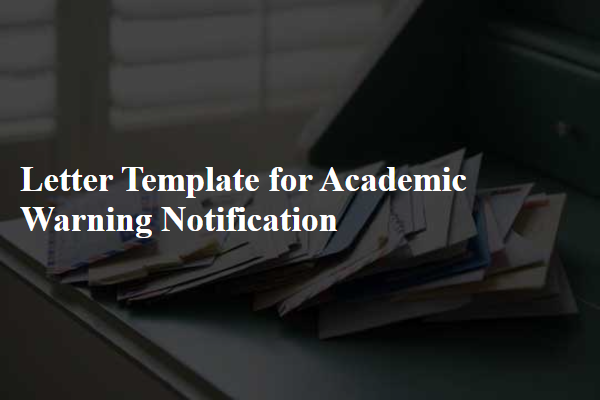Are you preparing for a faculty promotion and feeling a bit overwhelmed? Crafting the perfect letter to showcase your accomplishments and potential can be a daunting task, but it doesn't have to be. In this article, we'll explore essential tips and a customizable letter template that will not only highlight your achievements but also reflect your dedication to your field. So, let's dive in and discover how to create a compelling case for your promotion!

Clear demonstration of academic achievements
A clear demonstration of academic achievements is essential when considering faculty promotion, showcasing the impact and contributions of individual faculty members. Tenured professors (usually with at least five years of service) should compile a comprehensive portfolio detailing peer-reviewed publications (with prestige metrics like Journal Impact Factor), conference presentations (including major annual events such as the American Educational Research Association), and funded research grants (noting amounts and funding agencies like the National Science Foundation). Teaching effectiveness is also crucial, supported by student evaluations or innovative curriculum development, using teaching awards as additional evidence. Furthermore, mentorship roles, community engagement efforts, and interdisciplinary collaborations should be highlighted, reflecting commitment to both scholarly excellence and institutional growth. This portfolio serves as a vital resource for promotion committees, enabling them to assess a faculty member's qualifications aligned with university values and standards.
Evidence of research contributions and impact
Research contributions significantly influence academic promotion. Publications in peer-reviewed journals, such as "Nature" or "IEEE Transactions," provide evidence of impactful findings. Citations, such as those listed in Google Scholar, reflect the research's influence within the scientific community. Successful grants from competitive agencies like the National Institutes of Health (NIH) or the National Science Foundation (NSF) indicate recognition and trust in research capabilities. Collaborative projects with industry partners or interdisciplinary teams can further amplify the impact of research. Presentations at prestigious conferences, like the American Association for the Advancement of Science (AAAS) meeting, highlight the dissemination of research findings to a wider audience. Ultimately, a robust portfolio demonstrating consistent contributions and measurable impacts supports faculty promotion considerations.
Strong teaching performance and student feedback
Strong teaching performance is crucial for faculty promotion consideration, particularly in higher education institutions such as universities and colleges. Effective educators consistently demonstrate clarity in course objectives and present material engagingly, fostering an environment conducive to learning. Positive student feedback, often collected through mid-semester evaluations and end-of-semester surveys, highlights the impact of teaching methods on student comprehension and satisfaction. Faculty members who receive high ratings in areas such as course organization, availability for consultation, and the ability to inspire critical thinking skills often distinguish themselves as candidates for promotion. Such achievements contribute not only to the academic success of students but also enhance the reputation of the institution as a center of excellence in education.
Documented service to the institution and community
Documented service to the institution and community can reflect an educator's commitment and contribution to the development of both the academic institution and surrounding local communities. Examples include participation in university committees (like curriculum development committees), where decisions impact student learning and institutional growth. Volunteer initiatives that enhance community engagement, such as organizing workshops for local high school students or collaborating with non-profit organizations (like Habitat for Humanity) can demonstrate invaluable outreach efforts. Furthermore, involvement in professional development programs or mentoring activities showcases support for colleagues. Attendance at community events, such as academic fairs or public lectures, and presenting information about university resources can also illustrate a faculty member's dedication to fostering relationships between the institution and the broader society. These actions contribute significantly to the reputation of the institution and the educational advancement of the community.
Peer and departmental endorsements
The process of faculty promotion consideration heavily relies on peer and departmental endorsements that provide insights into the candidate's contributions, achievements, and overall impact within the academic community. Peer endorsements typically come from colleagues who can attest to the candidate's teaching effectiveness, research quality, and service contributions. These endorsements, gathered from various faculty members within departments such as Mathematics, Biology, or Engineering, highlight collaborative initiatives, mentorship roles, and vital research projects presented at conferences like the American Educational Research Association Annual Meeting. Departmental endorsements from administration, such as department chairs or deans, reinforce the candidate's alignment with institutional values and strategic goals, emphasizing their role in curriculum development, grant acquisition, and student success initiatives. Such endorsements collectively create a comprehensive narrative reflecting the candidate's qualifications, thus reinforcing their case for promotion within academia.













Comments